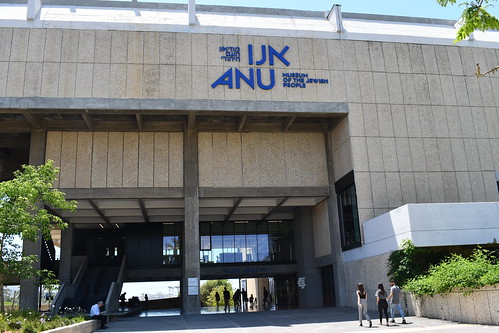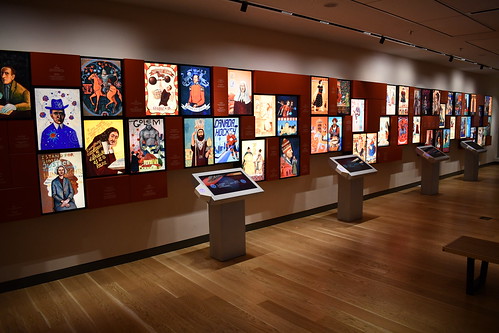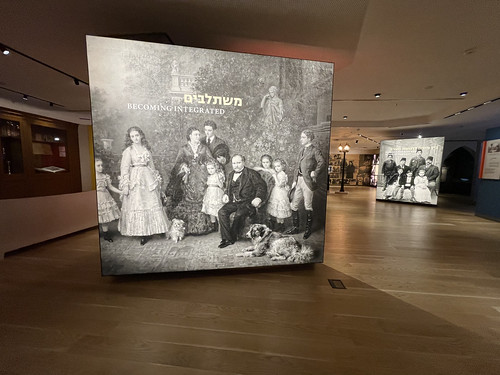After 10 years of planning and renovation, the largest and most comprehensive Jewish museum reopened in Tel Aviv In March 2021. ANU—Museum of the Jewish People is an incredible place for Jews and non-Jews to learn about Jewish history and culture. Jews can connect with their heritage while Gentiles can enhance their understanding of world Jewry throughout time. For anyone unfamiliar with the Hebrew language, the word Anu means “we” in Hebrew. The interactive exhibits on three floors acknowledge Jewish diversity and enable visitors to understand the role that Jews have played in various places throughout the world at different points in time.

ANU the Museum of the Jewish People Entrance
After receiving a 2021 press release from Grace Rankin, the North American Marketing and Sales Manager for ANU, I knew that I had to include a visit the next time Ira and I visited Israel. In the spring of 2022, we set aside time while staying in Tel Aviv to explore this impressive institution located on the campus of Tel Aviv University.
Unfortunately, our tour operator did not arrange a guided tour. Had I known that we would merely wander freely during our allotted time, I may have contacted the museum to arrange a guided tour with a museum docent. It should be noted that the museum differs from many other museums that are arranged in chronological order. By organizing the displays by themes, visitors use their own discretion to view what appeals to them. A guided tour may have augmented our understanding of the museum’s overarching goals.

Jews in the Arts
Unlike many places in Israel, the museum is open seven days a week, including the Jewish Sabbath. Visitors can visit for free on Fridays. Taking photos is encouraged. Grace Rankin recommends that visitors plan on spending at least two hours exploring the galleries and then visit the museum shop. If you see something you like, buy it. Currently, none of the gift items are available online. Just off the main lobby, visitors can grab a quick snack or drink at the Aroma Café.
As both a lifelong learner and an avid traveler of worldwide Jewish sites, I immediately became enthralled with ANU’s incredible selection of displays, artifacts, and video presentations. Instead of primarily focusing on the negative moments of Jewish history, the emphasis was on celebrating Jewish contributions, along with positive aspects of Jewish history. At the core of ANU’s foundation is the belief that modern Jews have a multi-faceted identity that extends beyond their religious beliefs. Today’s Jews can trace their beginnings to biblical times when the name “Jew” was given to the inhabitants of the ancient Kingdom of Judah.
We were instructed to begin on the third floor and then work our way back to the ground floor. The top floor is called The Mosaic—Modern Jewish Identity and Culture. To better understand the complexity of Jewish identity, visitors can listen to the digital displays depicting a cross section of Jewish personalities representing different ethnicities, denominations, and demographics.

Interactive Exhibits
Whenever Ira and I came upon an appealing theme, we stopped to learn more and occasionally stopped to watch a short video. As former history majors, it was sometimes challenging to move to the next area because there were so many interesting images and fact to absorb. Just about every subject imaginable was included. We enjoyed refreshing our memories about the role Jews have played in humor, theater, TV, music, and literature. There was even a section showcasing the accomplishments of women. As a foodie, I couldn’t resist looking at the interactive exhibit highlighting the diversity of Jewish cuisine which was influenced by approximately 80 different cultures.

Yiddish Theater
Our love for history went into high gear as we explored the exhibits on the second floor. After the destruction of the First Temple in Jerusalem in the 6th century BCE, Jews were forced to live in diverse communities outside the Land of Israel. Over the centuries, Jewish life ebbed and flowed in different places around the world and Jews became “a people among peoples.”

15th Century Haggadah
Visitors will learn how the destruction of the Second Temple affected communal life and how Jewish Middle Age life was centered in two distinct locations—Sepharad in the Iberian Peninsula and Ashkenaz in Western Germany and Northern France. The displays highlight where the Jews prospered and where they encountered persecution, anti-Semitism, and pogroms. By the 13th century, Jews were able to establish themselves in Poland and Lithuania and during the Inquisition many Jews migrated to the Ottoman Empire. During the European Age of Enlightenment, Jews were encouraged to assimilate. I wish it was possible to summarize the other key points covered in the museum. There are far more pivotal topics than I can possibly convey in this story. The good news is that if you find yourself in Tel Aviv, I encourage you to visit ANU.

Jews Becoming Integrated
Our time was running short by the time we reached the main floor, titled Foundations: a Common Core, a Universal Message. Since we have visited synagogues throughout the world, we headed directly to the exhibit showcasing synagogues past and present. By looking at the 21 models and an assortment of ritual artifacts, visitors better understand the uniqueness of each community.

Model of Tempio Maggiore, The Great Synagogue of Florence, Italy, Photo Courtesy of ANU
After spending less than two hours in the museum, Ira and I walked out of the building with positive feelings about our heritage. Due to the recurring theme of anti-Semitism throughout history, many Jewish museums have no choice but to focus on the ramifications of Jew hatred. By covering worldwide Jewish existence from biblical times, ANU offers a more comprehensive overview by shining a light on amazing Jewish people and their extraordinary accomplishments.

Theater Theme
In 2022, ANU—Museum of the Jewish People & Gallagher & Associates were awarded the Platinum MUSE Creative Award in the category of Experiential and Immersive Design.
Learn more: https://www.anumuseum.org.il/
Sandy Bornstein, the History Comes Alive Through Travel Editor for Wandering Educators, has visited more than 40 countries and lived as an international teacher in Bangalore, India. Sandy’s award-winning book, May This Be the Best Year of Your Life, is a resource for people contemplating an expat lifestyle and living outside their comfort zone. Sandy writes about Jewish culture and history, historical sites, family, intergenerational, and active midlife adventures highlighting land and water experiences.
Disclosure: Israel My Way provided a media rate for a 9-day private travel tour.
All photos courtesy and copyright Sandra Bornstein, except where noted
